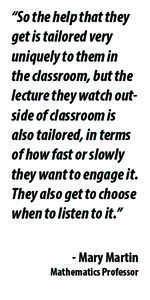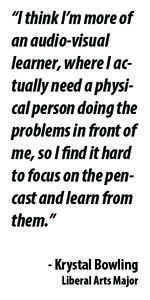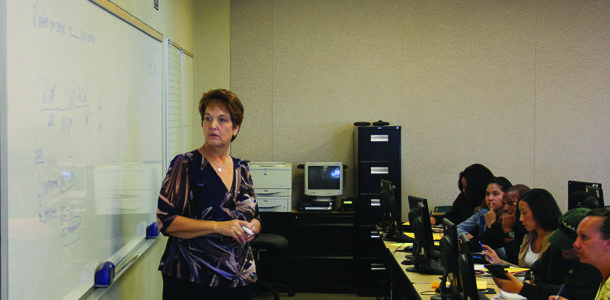A new pre-algebra class at Cosumnes River College may provide a glimpse into the future of education with the implementation of a new educational strategy called universal design.
Taught by mathematics Professor Mary Martin and offered for the first time this semester, the Math 30 course functions in part as a trial program to test the effectiveness of universal design in CRC classes.
“My understanding of universal design is that it creates a structure in a classroom that allows students to tailor their own learning based on their best learning modes,” Martin said.
 Universal design formats and creates lesson plans to best fit each student’s individual need in contrast to traditional teaching styles that address a class’s need as a whole.
Universal design formats and creates lesson plans to best fit each student’s individual need in contrast to traditional teaching styles that address a class’s need as a whole.
“Every student learns differently every day and in every class,” Martin said. “The best experience for me as an individual student is not going to match what the best experience is for the student sitting right next to me, which is why our tradition of teaching to a group doesn’t meet that individual need.”
In Martin’s vision of universal design, students use the Internet to access lessons and lectures at their convenience outside of class.
“In this class, the structure that I’ve created is a flipped classroom where [students] watch the lectures outside of class, which means they can watch the lectures slower, they can slow them down, they can stop them and rewind them, so the pace at which they get the initial lecture is very customizable,” Martin said. “It’s like having your teacher recorded so you can control the pace.”
When students return to class, Martin refreshes them with a short lecture and examples of math problems that are heavy on class participation.
“When I come in, I’ve already lectured to them,” Martin said. “What I typically do is a quick check for understanding, and then usually what we do is apply what they learned, and then they start to work in class on what they’d usually do as homework.”
While students work on their homework assignments, Martin walks around the classroom and addresses each student’s questions.
“This way, students can ask very precise, individual questions and get very precise, individual answers,” Martin said. “So the help that they get is tailored very uniquely to them in the classroom, but the lecture they watch outside of classroom is also tailored, in terms of how fast or slowly they want to engage it. They also get to choose when to listen to it.”
Technology is a major factor for Martin in employing universal design in her classroom. One of the most prominent tools in the lesson plan is the smartpen.
“I use a Livescribe Smartpen,” Martin said. “It writes like a regular pen, but it has a recording device in it, so it not only creates a digital copy of what I write, it also records the audio tracks of my descriptions as I’m writing them.”
The “pencast”, as the recording is called, is then uploaded to a website where students can access the lecture at their leisure, like D2L or Pearson lab websites.
While the use of technology is a great asset to Martin’s personal use of universal design in a class setting, it is also at times the biggest weakness of the educational strategy.
“That’s both the advantage and the disadvantage,” said Martin. “Making it individualized requires the technology, but because it requires technology, there were a lot of issues up front with students getting adobe reader installed and making sure they had access to computers, if their computer at home wasn’t working, making sure they had time to come into the math lab or one of the other labs to make sure they got the pencast here.”
 Students in Martin’s Math 30 class were mainly positive about the changes universal design brought to the often-challenging environment of college-level math.
Students in Martin’s Math 30 class were mainly positive about the changes universal design brought to the often-challenging environment of college-level math.
The class has been a huge benefit to Sandra Otawa, a 51-year-old, general education for transfer major.
“For me, it’s been really beneficial, it’s easier for me to grasp the concepts this way,” Otawa said. “I know that I can listen to that pencast more than once, because when I’m in a traditional class and the teacher will give a lecture, that would be it, and he or she would go through the lecture really quick. If you don’t grasp anything, you’re done.”
Otawa, a student with a learning disability who has struggled with math as it is taught in traditional classrooms, has seen huge improvement in her abilities since starting the class.
“I love this class, I haven’t used the disability center at all this semester, and I’m doing the best I’ve ever done in a math class,” Otawa said. “It really makes you feel like you’re accomplishing something.”
However, some students found the alternative lesson plan of a class designed universally to be less helpful than more traditionally structured classes.
“I love the teacher, I love Miss Martin, and she’s really great at explaining things that we do have problems with and spending one-on-one time with us,” said Krystal Bowling, a 32-year-old, liberal arts with a concentration in math and science major. “But I would rather have her lecture and teach me in class than have me go home and do it.”
One of the biggest problems for Bowling was the use of pencasts to present lectures outside of class.
“I don’t like the pencasts at all,” Bowling said.
“I think I’m more of an audio-visual learner, where I actually need a physical person doing the problems in front of me, so I find it hard to focus on the pencast and learn from them.
Martin believes that the class has seen a very promising trial period, and hopes that more classes implementing universal design will appear on campus in the future.
“I have two other instructors who are interested, in the math department, that are looking for fall classes, creating a design similar to this flipped classroom,” Martin said. “But we’re still working on making that happen.”

